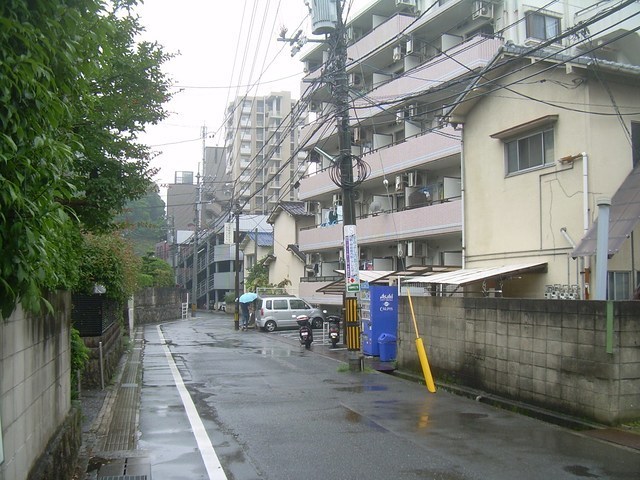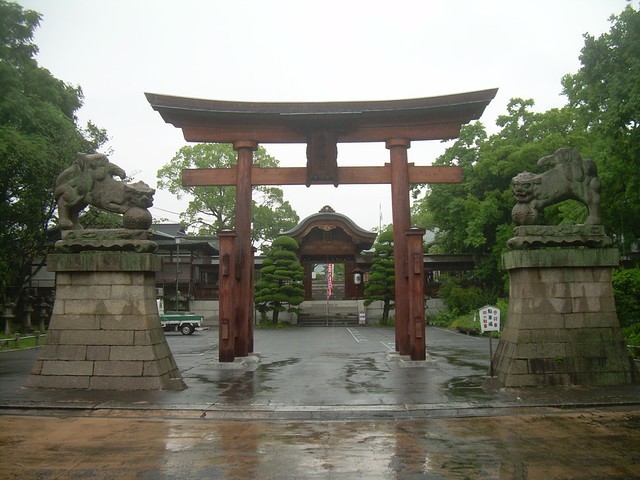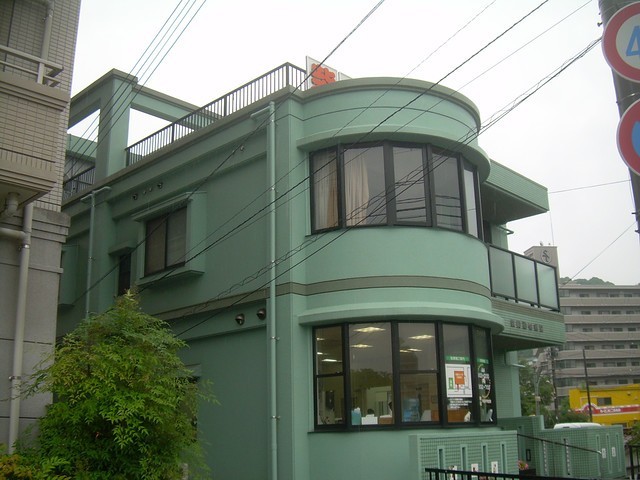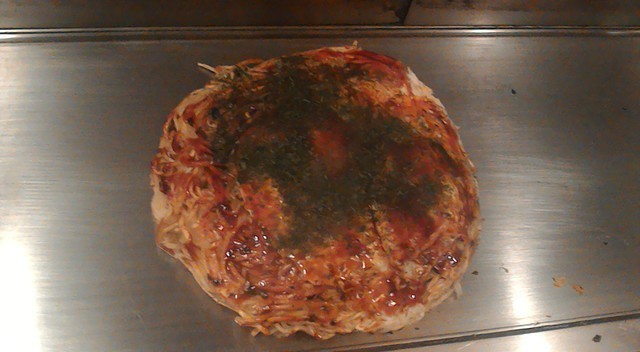Hiroshima - Temple walk and Kagura
| Travel Reports by FancyLampshade | view profile of FancyLampshade |
| previous post |
|
| Note: The opinions and views expressed in this user report are those of the individual author and do not necessarily reflect the opinions and views of japan-guide.com. |
June 29, 2016 - Hiroshima - Temple walk and Kagura
Despite the saddening first day in Hiroshima I woke up in a good mood the next day and excited to get started. The weather lived up to my hopes of what the rainy season would offer, pouring hard and strong all day long. I donft see rain often in Spain which is a pity since I think it is absolutely beautiful (need I say itfs my favourite weather?), so while Ifm sure many tourists of the hostel cursed their luck that morning as they looked up at the sky, I was delighted.
The rain wouldnft be interfering with my plans so I set off to Hondori Station to catch the Astram Line to Fudoin-mae Station. Today I had planned the Futabanosato Historical Walking Trail --in other words, a temple walk in the north area of the city-- and a special show for later in the afternoon. I didnft know how long the walk would take me so I kept my itinerary open just in case.

Temples and shrines arenft usually what come to mind when one thinks of Hiroshima, but it is true that there are still a few in parts further away from the city centre that survived the bombing and a few of those which didnft where built once again in the same location. My main goal to do the Hiroshima Temple walk wasnft to see temples though --Ifd already seen plenty and would still be seeing more in the days to come-- it was rather to get to know the residential areas of the city and how people lived today, in a Hiroshima that has raised from the ashes and pain it once felt but today has an identity of its own beyond the bombing.
It wasnft a particularly breathtaking walk, but it kept me entertained and I enjoyed being outside in the fresh air after so many days of heat. I feel like there isnft enough information available in English regarding this route, at least I didnft find as much as I wouldfve liked, so Ifll try my best to explain how it was.

Hiroshimafs history started more than 400 years ago when Mori Terumoto built a castle on the delta, near an already existing small town, and developed the area into a striving castle town. Mori Terumoto, Fukushima Masanori and the Asano clan (so many important names belonging to the history of Japan, I canft believe they were all here!) erected shrines and temples, along some that were already much older, north of the castle to defend the domain. The Futabanosato Historical Walking Trail visits a few of those which were rebuilt as well as passing through the Waterworks Museum (which I forgot about / didnft find) and the Peace Pagoda. For those who donft have the time to do the whole walk there is a shorter version only counting seven of the temples, although they are dedicated to Shichi Fukujin (the 7 Lucky Gods), so I guess they are the most important of the route.

But enough explanations, letfs just get down to what I did personally. The train was empty, only myself and another girl occupied the car, and my station was announced much earlier than expected. Exiting the station I found a sign right away pointing the direction to the first temple of the route, Fudo-in. Fudo-in promised to be the most impressive although it turned out to be pretty small. What was certainly impressive was the Niomon Gate at the entrance, two stories tall and a combination of brown, white and black that emphasised its elegance. The old priest of the temple accompanied Hideyoshi on his invasion of Korea and itfs said that the timbers to build the gate came from the country.
I actually didnft see too many Nio statues this trip so it was good to see the two there greeting me on my way in.
The main hall, the Kondo, is the largest remaining example of Karayo building in Japan. Karayo was the Chinese style of architecture that was particularly popular with Zen temples in Japan. A bell tower, a small inari shrine and an overgrown garden are the only other things in the temple grounds, so it wasnft long until I was heading off to the next site.

It took me about an hour and a half to get from Fudo-in to Anraku-ji. It shouldnft really take that long but I was walking slowly and took the long route along the river instead of through the streets, stopping every now and then to look at the white and grey herons. I couldnft find any of the other three temples or shrines in-between so I backtracked and took a different street every now and then around where the shrines were supposed to be. I also walked all the way down to Hakushima Station accidentally because I skipped the zebra crossing before the bridge and ended up doing a very long loop to get back on track. A man saw me walk past outside a gas station and he waved to me enthusiastically.

Anraku-ji is small but the streets in the area are lovely. I sat down on the only bench I found all day that wasnft soaking wet at the temple and watched a few women pass by on their way to the cemetery behind the temple before continuing. It wouldfve been more work than desired to get to just one of the temples, but combining all of them together made it worth it. Walking through back streets and seeing Japanfs daily life in the city (in the rain!) was very nice and I even pictured myself living in a place like this.


The next four temples were very close together and easy to find. Nigitsu Shrine (one of the Shichi Fukujin, dedicated to Ebisu) had a man that was for some reason measuring the statues. Myojo-in (dedicated to Bishamonten) is next to a pre-school and was filled with the voices of shouting children as well as plenty of interesting statues and Tsuruhane Jinja (Benzaiten) had a team of men cutting leaves of trees under the heavy rain.


Toshogu Shrine (Fukurokuju) was the only one where I found other visitors, but most of them were leaving in their cars or where inside the closed building. I didnft know if I was welcome inside since the door was closed and seemed unwelcoming, so I asked a miko where I could get a goshuin stamp instead of attempting to enter off-limits territory. She may have been the loveliest person I met in Hiroshima, her smile when I asked about the shrine stamp was almost blinding and she took my stamp book away happily, asking me kindly to please wait for a while until she returned. She came back with my shuincho as well as a map of the route I was doing, and was surprised that I intended to go all the way up to the Peace Pagoda in this weather.



Looking back, I admit it may not have been the brightest idea. Kinko Inari Shrine, which for some unknown reason I always call Kusado Inari Shrine, is right behind Toshogu-jinja and torii lead up the mountain path heading to the Peace Pagoda for a while. The torii were pretty short, so I had to duck my head while walking under them. Small fox figurines and cute little shrines next to the steps appeared at every corner (the steps did a zig-zag path), the light hardly reached the ground through the trees and it felt like I was walking into a realm of unknown spirits as the path only got darker, as if the foxes eyes were following me as I continued.

I eventually abandoned my umbrella when the path only got thinner and I had to duck more, although the occasional droplets fell onto me and slid down my back. I felt lucky that I had decided to bring my thin jumper on the trip after all. After a while I came across a small covered structure that I decided to hide under as I sat on the floor and rested my legs for a while. When the mosquito flying around me got too annoying I continued my way. The trail wasnft very clear so I climbed up a few rocks and through an opening that looked like it could be the continuation of a path. It probably wasnft though, for only bushes and small slopes could be seen on the floor of the mountain rather than a walking route.

Soon I was lost, walking around a forested mountain in the rain. The only person who knew where I was was the miko of Toshogu Shrine, if something happened to me I doubted anyone would be finding me anytime soon, but just as I thought that I spotted a clearing where the white sky and fog finally made an appearance. Some stairs leading somewhere around the corner, I knew I had made it to my destination and, sure enough, around said corner I could see the spike of the pagoda peeking out from the top of the stairs.
For something that can be seen from so far away it was smaller than I had imagined, but no less impressive. Apparently there are supposed to be good views of the city below but I only saw white and silence. I didnft want to let go of the ambience that permeated the air (I was still fixated on the inari shrines and hoped a yokai procession would make an appearance) so I stuck around for a half hour until I started to get cold.

I decided to make my way back to Hiroshima Station instead of continuing with the temple walk, Ifd already seen my must-sees and the shrines left were further apart and harder to find. The station was mostly a straight line from the pagoda and I didnft have to look where I was going because it seemed like everything gravitated towards the station anyway. I mentioned a couple of posts ago that I managed to see a shinkansen in person during my trip: today was the day! A sleek bullet train slid by in front of me into the station and out of sight, but it was enough for me to let go of the mysterious mood and almost jump up and down in excitement.

The station was abuzz with baseball fans dressed in red and white and face paint, apparently Hiroshimafs baseball team was playing today and had everyone in a good mood.
Ifd been mostly living off konbini bentos since the start of the trip, so I decided to have a big lunch before resting a while at the hostel. I met a family of catalans from around Barcelona who were in for their first trip to Japan, after Hiroshima heading up to Magome and Tsumago along the Nakahechi route (jealous!). I met sixteen catalans during the next week, which is especially impressive considering Catalonia isnft really that big. It seems like Japan is a tourist magnet ever since the Barcelona manga-boom from three years ago.

I also finally managed to pick up my pass and just outside the Bus Centre Information Corner there were a few people selling fresh vegetables at some stalls. I bought a see-through peach mochi from one of the sellers, I can finally cross eeat mochi from a leaff off my bucket list! Definitely one of the best, if not the best, mochi Ifve ever tried. The ones Ifve eaten in Japan so far seem to all be filled with red bean paste that isnft fully crushed, leaving bits of the bean skin in the paste inside, while the ones I buy at the Chinese wholesale food supermarket here in Spain all have the paste fully crushed and homogenous. I personally like the homogenous paste better although Ifve now gotten used to both styles.

Moving on, there is a place in Hiroshima where they do kagura shows every Wednesday, kagura is a traditional Japanese performance (also has only male actors like Noh and Kabuki) focusing on the dancing aspect. But before I start telling you about the show I went to and to better understand the significance of kagura, a story is in order.
Susanoo seemed to have a few anger management issues, and when once upon a time he got angry and destroyed his sister Amaterasufs land out of jealousy, Amaterasu fled and hid in a cave taking with her the light from the world for she was (is?) the sun goddess. With the earth in darkness the land soon became infested with demons and evil; people came from far and wide to try and get Amaterasu to return and shed her light once again. After many attempts to convince Amaterasu to leave the cave, it was Uzume who finally managed. She hung a mirror and jewels (two of the three Imperial Regalia of Japan) outside the cave and danced -- the cheers of the other people made Amaterasu peek outside to see what was worth so much noisec when she saw her own reflection in the mirror she was startled enough that the others could pull her out of the cave. Uzumefs performance is said to be the origins of Japanese dance and more specifically a kagura dance.

Kagura is common in Hiroshima and Shimane Prefectures, so I wanted to see if I could see an example during my stay as part of getting to know the culture of the area I was in. This theatre in Hiroshima (at the Prefectural Cultural Centre) has two different shows every Wednesday; the first starts at 7pm and the second at 8pm --two different stories--, both lasting about 45min with an intermission session between them.
I didnft know how many people there would be so I arrived a bit before 5pm, time when they start selling tickets, to make sure I would have a seat. There are two entrances to the hall and both are easy to see if you know where the theatre is. I thought I had found a little known treat to enjoy with the locals, but there were many people in the common area waiting around and even a couple other foreigners later on. This isnft something I would ever dream of doing elsewhere, but I found it safe enough to abandon my bag in line as I went out to walk around until the doors opened (to be fair, many did the same).
There were plenty of spaces available even if I had arrived later --more than half the theatre--, but the regulars were very excited and ran in quickly as soon as the doors opened to get the best seats. It was funny to see older men and women scurry along, almost pushing past just so they could get a good spot.

Photos are only allowed in certain areas of the theatre so I took a seat further back to take some photos, however I was so enraptured by the show I totally forgot about my camera and didnft end up taking any! Another foreigner sat next to me so we talked until the lights were turned off and the musicians appeared on stage. After a few bows the four of them sat in a corner of the stage, not out of view for the music was an important part of the show, and the flute began playing as the first act started.
As the legend goes, Prince Yamato killed his older brother. His grieving father King Keiko, fearing the evil nature of his son, sent him to Izumo Province and then to the land of Kumaso (Kumamoto Prefecture) to battle against rebels, hence keeping him at a safe distance.
There are many stories regarding his adventures, but we are interested in the one that explains how he defeated the Kumaso warriors as that is the theme of the kagura show. He disguised himself as a maid attendant and infiltrated himself into the banquet where the Kumaso were feasting and drinking. The Kumaso warriors didnft realise it was simply a disguise and kept drinking as quickly as possible. When the Kumasos had become drunk, the prince made the most of the opportunity and stabbed them to death. As one of them lay dying he praised Yamato for his well thought-out plan and gave him the title of eYamato Takeruf, eThe Bravest of Yamatof.

Fun fact: before departing to Izumo he prayed at Ise Shrine asking for the blessing of Amaterasu already mentioned, and later during his life he came to possess the eKusanagi no tsurugif sacred sword (the last of the three of Japanfs Imperial Regalia) which Susano-o gave to Amaterasu to ask for her forgiveness after his rampage that sent her to the cave! It really just ties the whole kagura experience together, knowing that they are all connected somehow.
The kagura had its own version of the legend, making Yamato Takeru fight against the Kumaso warriors once they were drunk instead of a simple quick stabbing. Totally worth it though, the sword fight was the best part since there were the six actors on stage dancing around together so rapidly and with much grace that I suspect wouldnft feature in a real sword fight. Even though I knew how the story went the show had me on the edge of my seat, excited and impressed, hoping the show would never end for the full 45 minutes. At one point the actors were twirling around each other, Yamato Takerufs men unclipped their clothes and their costumes reversed, showing a burst of colour as they danced in circles. The crowd and myself went wild clapping and cheering, for me it was totally unexpected and the fight that followed only seemed more intense now that the ambience had changed so dramatically.

Even after 45min of dancing the act seemed to end too soon. We werenft allowed to eat food in the theatre so I thought that the bag of snacks Ifd bought just before going in had been rendered pointless, but seeing as many people left through a side hallway leading to the emergency exit doors I decided to follow them. Turns out there is a seating area and some bathrooms at the end of the hall and served as a good space to eat said snacks and stretch my legs during the intermission.
When I was in high school I wrote a 70 page project about the movie eSpirited Awayf from Hayao Miyazaki, looking into aspects of Japanese history, folklore and real life influences that the movie had and this introduced me to the world of yokai, led me to reading eKwaidanf from Lafcadio Hearn and researching all kinds of Japanese monsters. Itfs really what sparked my interest for Japan and still today legends and mythology are two of my favourite aspects of Japanese culture. The character Kamaji from the Ghibli movie was inspired by the Tsuchigumo, so I was familiar with the legend before arriving to Hiroshima, but they gave me a sheet of paper in English explaining the two shows anyway and it was useful since I had never heard of the first one.

Hence, Tsuchigumo is a personal favourite yokai of mine and was what I was really looking forward to (both shows were amazing though, I couldnft choose which one I liked best).
The second actfs story featured Minamoto no Raiko. He was ill in bed with chills and fever and thus sent his maid, Kocho, to a doctor in order to pick up some medicine. On her way back Kocho was killed by the Tsuchigumo, a spider demon, who disguised himself as the maid so he could once and for all solve the deep-seated grudge he held against Raiko.
Tsuchigumo changed the medicine for poison, but Raiko noticed something was off and attacked the impostor with his sword Hizamaru. His retainers Urabe Suetake and Sakata no Kintoki followed Tsuchigumo as he fled to his home in Mt.Katsuragi and, after a fierce battle, finally defeated the demon.
The producers really put in a lot of effort to make the best show they could, even a waterfall of cobwebs (strings) fell around Tsuchigumo as he entered the scene, and was present during the whole show even as Tsuchigumo, defeated, fell to the floor with a flip of his white shaggy hair.

During the battle the taiko drummer, who had been sitting down, stood up to be able to hit the drum as hard as he could, each beat matching the intensity of the fight. He looked like he was thoroughly enjoying himself and trying his best, I could see the sweat rolling down his forehead all the way from my seat.
What really wrapped up the whole experience was being able to try on the costumes after the show. The costumes were heavy and definitely difficult to dance with but beautifully embroidered, many ran up to me and asked for photos once I put on the Tsuchigumo mask. I was honoured to be able to meet the taiko drummer for he really made the kagura show much more memorable and exciting.
Only 1000yen I think it is a great way to learn about Japanese culture and have an amazing time. I couldnft wipe the smile off my face for the rest of the night.

Before heading to my futon I found a teppanyaki restaurant to have some of Hiroshimafs okonomiyaki. I couldnft leave Hiroshima without tasting it since I was trying to be slightly more open with my food choices this trip (Ifm a picky eater). After my failed acceptance of Kurashikifs udon and Onomichifs ramen, Ifm glad to announce that I enjoyed the okonomiyaki! It was a bit difficult to cut but I managed to get the hang of it by the last few slices, and seeing the woman cook it in front of me was fun.
Day two in Hiroshima turned out to be just as memorable as day one. I was already jittery with excitement and wished the next morning would come soon.
(My shoes took three days to dry.)
| previous post |
|
|
List of Posts:
2016/06/29 - Hiroshima - Temple walk and Kagura 2016/06/28 - Hiroshima - Peace sites 2016/06/27 - Onomichi (Hiroshima Prefecture) 2016/06/26 - Kurashiki (Okayama Prefecture) 2016/06/25 - Bizen (Okayama Prefecture) 2016/06/25 - Mount Shosha (Engyoji Temple) |
